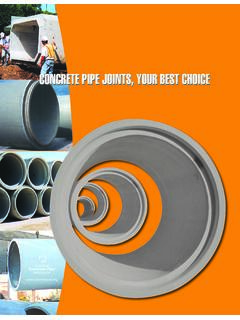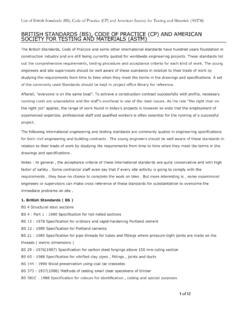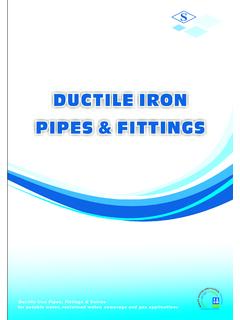Transcription of Sealant Adhesion & Compatibility Study Report
1 Sealant Adhesion & Compatibility Study Report Date: October 1, 2013; revised February 2014. To: QA/QC. From: Sharon Libby, WCC. Re: Sealant Adhesion and Compatibility Study Introduction - Purpose of the experiment: Sealant Adhesion and Compatibility are critical parts of designing and specifying weatherproofing systems in buildings. In general, sealants are used for both weather / air tightness sealing and in structural joints, which can also be part of the air and moisture control layers. Sealants must possess certain properties in order to properly work as air and moisture controls. Those properties almost always include Adhesion to various substrates such as weather-resistive barriers (WRBs), self-adhered membranes (SAMs), liquid-applied membranes (LAMs), roofing membranes, and cladding materials.
2 Chemical Compatibility is also important as it is typical in construction to have various materials in contact with one another. This contact can occur as designed, as in the case of a window perimeter Sealant joint that touches both the window frame and the adjacent cladding. It can also occur inadvertently, such as asphaltic or butyl vapor migration from a post-wrap SAM over a window flange through a backer rod, discoloring the Sealant . Depending on specific field applications and adjacent materials, the properties critical to and required for a project may vary. However, for the purposes of comparing several sealants and substrates, Adhesion is tested with quantifiable results in this Study : Resistance is measured in pounds at the point of failure, using a standard pull test procedure.
3 The failure modes are also recorded. Compatibility is a qualitative observation that is noted at the time of the pull tests. Discoloration or staining of the Sealant and/or the substrate is one typical sign of a reaction between the materials. Other qualitative types of information recorded are generally comparisons of observations related to conducting the pull tests such as workability, elongation, and curing processes. The goals of this Sealant Study are to: Observe and compare various sealants applied to typical substrates. Test recommended and inadvertent applications. Gain a general understanding of Sealant and substrate chemistry in relation to how they are expected to perform in field applications.
4 Measure Adhesion and record modes of failure. Create a document with comparative analysis of the tested sealants to substrates that can be used as a guide to select sealants appropriate for use with given substrates. QA. QC. Copyright Walsh Construction Co. 2013 . How this Study relates to other testing: Pre-construction Sealant testing is common at both the manufacturer and contractor level and is required by many specifications. Sealants manufacturers test in their labs to verify a variety of properties that are usually listed on the product's data sheet. They can include: working time, flow (sag or slump), VOC content, tensile Adhesion strength, elongation, and joint movement capability.
5 These Typical Properties are referenced to an ASTM or other standard where applicable, and are measured properties. Manufacturers also test for compatibilities with typical substrate materials and list Approved Substrates as part of the Sealant 's product data. Pre-construction field Adhesion testing is commonly specified and is typically conducted by the manufacturers'. field representatives. In practice, it is best to test the actual materials that will be used in construction as unannounced manufacturing changes can alter material chemistry and performance. Simple pull tests with a tooled Sealant bead against a single substrate should be done first.
6 Once a mock-up is constructed joint testing can be done not only with the actual materials, but also in their actual application and dimension. Testing a movement joint with two substrates is very different than the previously described single substrate test;. however, both provide critical information during pre-construction. In-service field Adhesion testing is typically required throughout the construction duration, as well, for the same reasons of verifying Adhesion and Compatibility . ASTM C1521-09 Standard Practice for Evaluating Adhesion of Installed Weatherproofing Sealant Joints is a commonly used standard that describes various Adhesion testing methods for in-service Sealant joints.
7 This Study and testing closely relates to pre-construction field Adhesion testing, with a single bead of tooled Sealant pulled from a single substrate. The Study does not follow any ASTM standard. Procedure: Test Boards & Substrates Test boards for WRBs and SAMs were made with two strips, generally 12 tall x 48 in length, of each material applied to 48 x 32 corrugated plastic boards. Blue painters tape was applied at the top edge1 of the membrane to serve as a release and starter for the pull tab of Sealant . LAMs were applied to exterior grade gypsum sheathing in two strips, generally 12 tall x 48 in length. The LAMs were applied at the manufacturer's recommended millage.
8 Cladding materials ranged in size and shape available. Each cladding substrate had Sealant beads applied as best fitted to the sample. Copyright Walsh Construction Co. 2013 2. Sealant Bead Application Generally, three beads of each Sealant tested were applied to each substrate. The beads were between 8 and 12 in length to be sufficient for both a pull tab and pulling distance. The beads were also purposefully continued across the edge1 of the WRBs and SAMs to test for Compatibility with both the membrane facing and adhesive backing layers. All sealants were tooled with a Sealant tool to obtain consistent contact with the substrate. During the Sealant bead application and testing process it was found that the bead size, specifically the depth of the bead, was an important factor in getting a sufficiently sized pull tab and thus pull test from each bead.
9 Some sealants tended to flatten and shrink after application leading to difficulty in creating a pull tab for testing. Larger bead sizes allowed for better pulls; however, this change throughout the testing could have lead to inconsistency in results due to a change in surface area contact and cross sectional area of each bead. For each pairing, the test beads were applied at the same time and in the same general dimension. Therefore, the results are still relative and able to be compared to each other. Sealant & Substrate Pairing A matrix of Sealant and substrate types was created using both manufacturer approved substrates for each Sealant as well as typically specified sealants and substrates.
10 Consideration was also given to typical membrane and cladding junctures such as at transitions, penetrations, flashings, or at cladding material terminations. Manufacturers' product data was referenced and technical representatives were contacted to provide feedback on substrate and primer suggestions. Not every Sealant / substrate pairing was directly recommended by the manufacturers of either, but was still tested to complete the comparisons established by the matrix. The goal of gaining a general understanding of how each Sealant adheres to various substrates and the comparison between related substrates and related sealants prevailed in this decision for testing.




